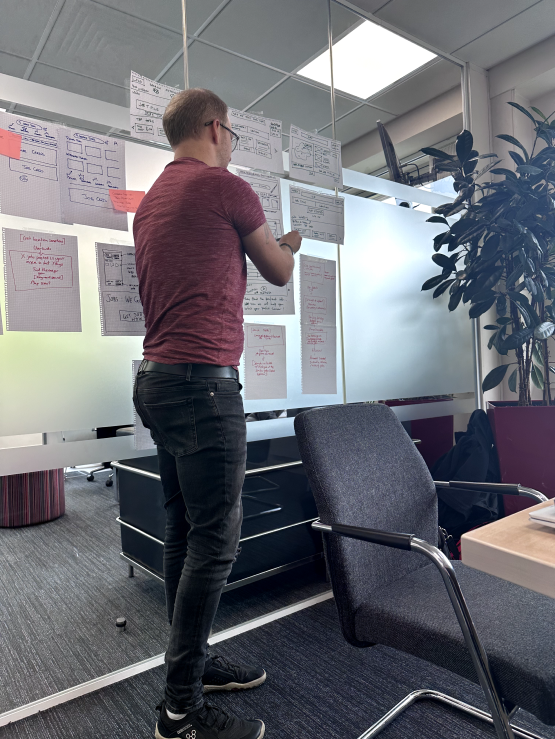
Redesigning the Homepage for Resume-Library and CV-Library
Business Challenge
Market Context:
Resume-Library and CV-Library are prominent platforms connecting job seekers with employers. However, their high homepage bounce rates and low user engagement hinder their potential for conversion and growth in a competitive market.
Revenue Impact:
The platforms face significant revenue challenges, as bounce rates directly impact ad impressions, user registrations, and job application rates—critical revenue streams.
User Pain Points:
High Bounce Rate:
90% (Resume-Library) and 80% (CV-Library) of users leave without interacting.
Low Conversion to Job Search:
Only 1% (Resume-Library) and 5% (CV-Library) of users proceed from the homepage to job search results.
Poor Engagement with Content:
The "Companies" and "Register" sections see minimal interaction (0.3% and 0.6% tap rates, respectively).
Mobile Users’ Limited Scrolling:
Only 50% scroll far enough to see featured content.
Cost of Problems:
High user attrition translates into lost advertising revenue, underutilised features, and missed opportunities for brand differentiation.
Furthermore, the lack of a compelling user journey increases costs associated with user acquisition.
Strategic Approach
Research Insights:
Pre-sprint user research revealed key issues:
Users feel overwhelmed by cluttered layouts and unclear value propositions.
The job search function is buried and unintuitive.
Mobile users face difficulty accessing key information quickly.
Solution Framework:
The challenge was tackled using a 5-day Design Sprint focused on rapid ideation, prototyping, and user testing.
Design Sprint Approach:
Day 1: Understand the Problem
Defined long-term objectives: reduce bounce rates, increase engagement, and drive job search conversions.
Mapped user pain points and prioritized solutions.
Day 2: Diverge
Brainstormed multiple approaches, focusing on enhancing clarity, usability, and engagement.
Day 3: Converge
Selected the most promising solutions through critique and created a comprehensive storyboard.
Day 4: Prototype
Built a low-fidelity but functional prototype focusing on a simplified, mobile-first homepage design.
Day 5: Test
Conducted user interviews to validate solutions and gather actionable insights.
Decision Criteria:
The final design decisions were guided by:
Clarity of the value proposition.
Ease of access to critical features like job search.
Increased visibility for underperforming sections like “Companies” and “Register.”
Implementation Plan:
Short Term: Deploy redesigned homepage and conduct A/B testing.
Mid Term: Refine the user interface based on analytics and user feedback.
Long Term: Scale successful design elements to other pages.
Talking works!
Making sure
I chat to engineers all the way through the design process
Final Design, launched…
Revenue Increase:
Projected an uplift in ad revenue due to improved engagement and lower bounce rates.
User Metrics:
Bounce Rate Reduction: Early tests showed a 25% reduction in bounce rates.
Job Search Conversion: Increased from 1% to 4% (Resume-Library) and 5% to 10% (CV-Library).
Engagement with Content: Interaction rates for the “Companies” and “Register” sections improved to 2% and 4%, respectively.
Performance Data:
User feedback highlighted improved usability and understanding of platform benefits, particularly on mobile devices.
SLT Testimonials:
“The Design Sprint gave us a refreshed homepage and a roadmap for improving user journeys across our platform.”
By focusing on empathy, collaboration, and iteration, this case study exemplifies how Design Sprints can transform complex challenges into actionable solutions that deliver measurable results.
Why This Works:
Speaks to Business Goals: Directly addresses bounce rates and conversions, aligning with revenue objectives.
Shows Strategic Thinking: Leverages insights from research and rapid iteration via the Design Sprint.
Proves Real-World Impact: Demonstrates tangible improvements in key metrics post-implementation.
Justifies Investment: Validates the cost and effort of the redesign through measurable user engagement and satisfaction.
Implementation Steps
Audit the Current Homepage: Identify bottlenecks in user flow and prioritize improvements.
Reorganize Content Hierarchies: Surface critical features like job search while simplifying the layout.
Test Iterations: Use A/B testing to refine the design based on user behavior.
Track Metrics: Monitor changes in bounce rates, click-through rates, and overall engagement.







